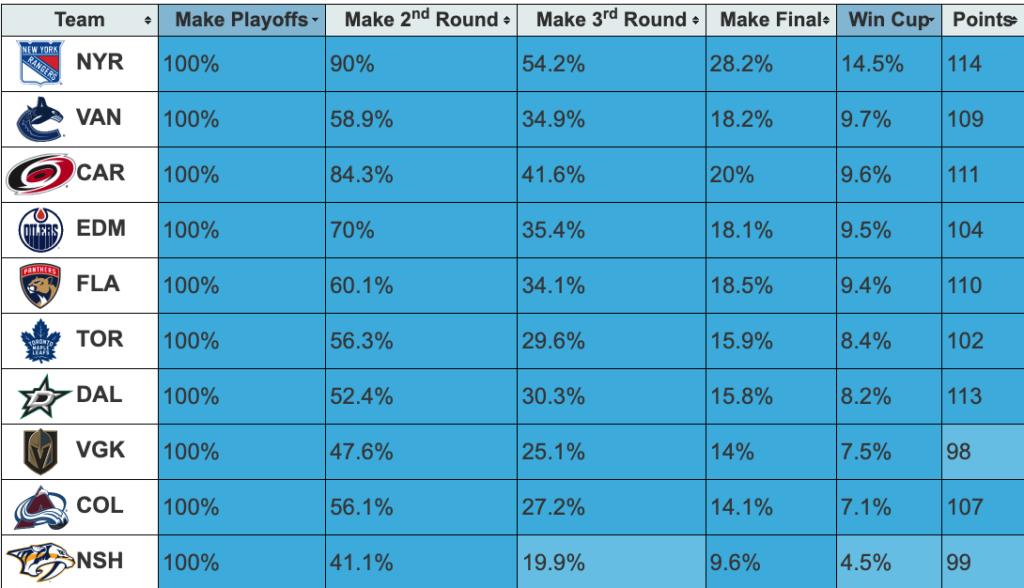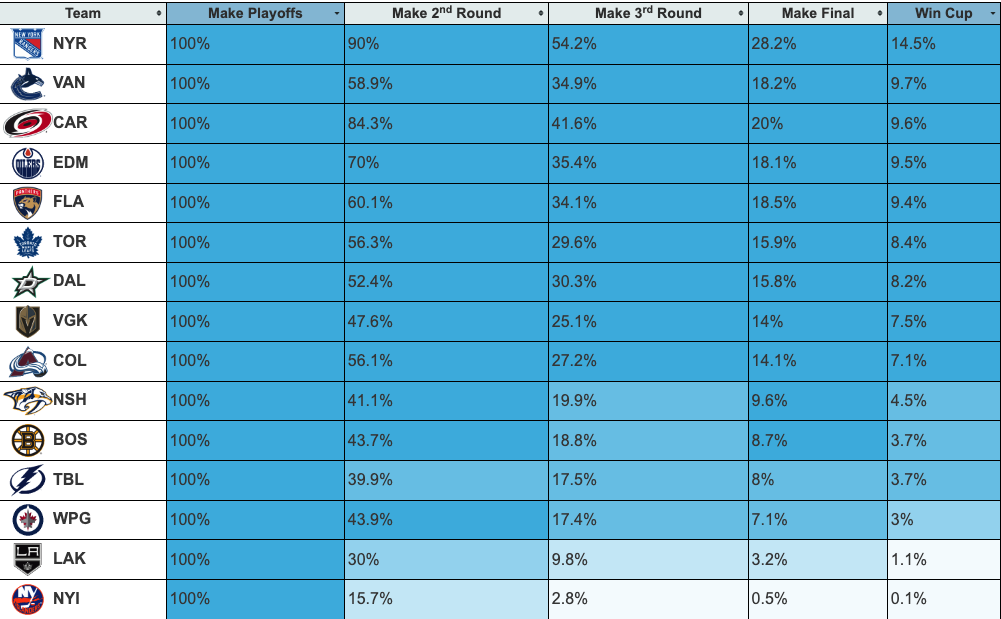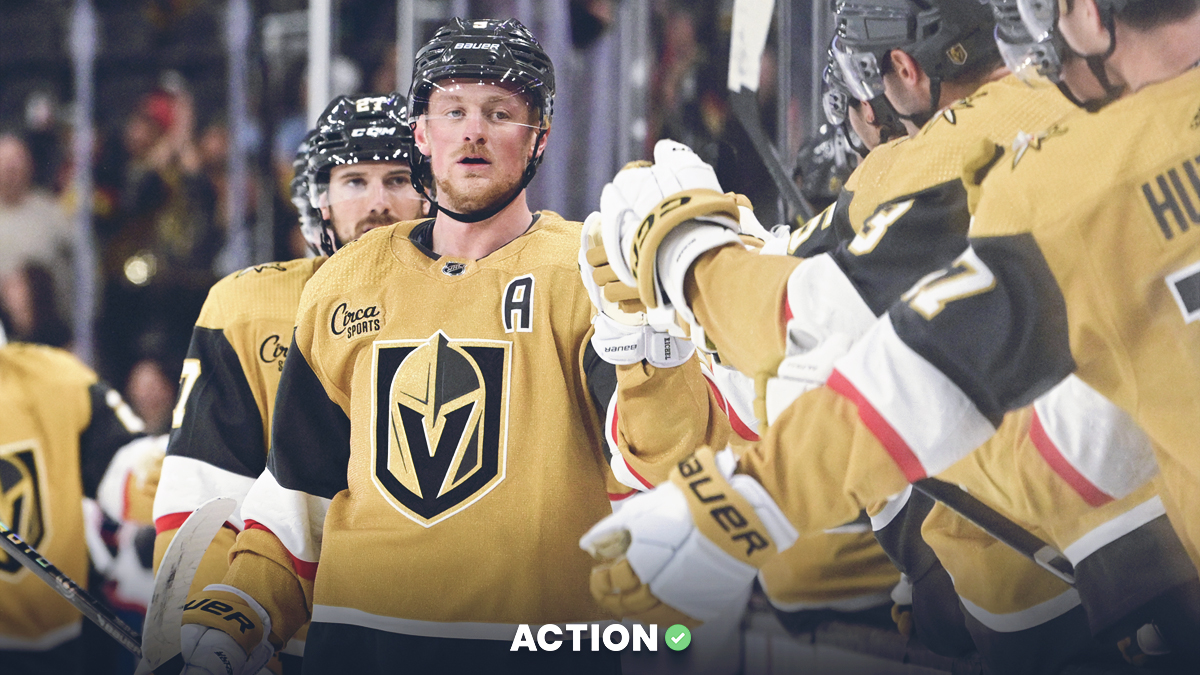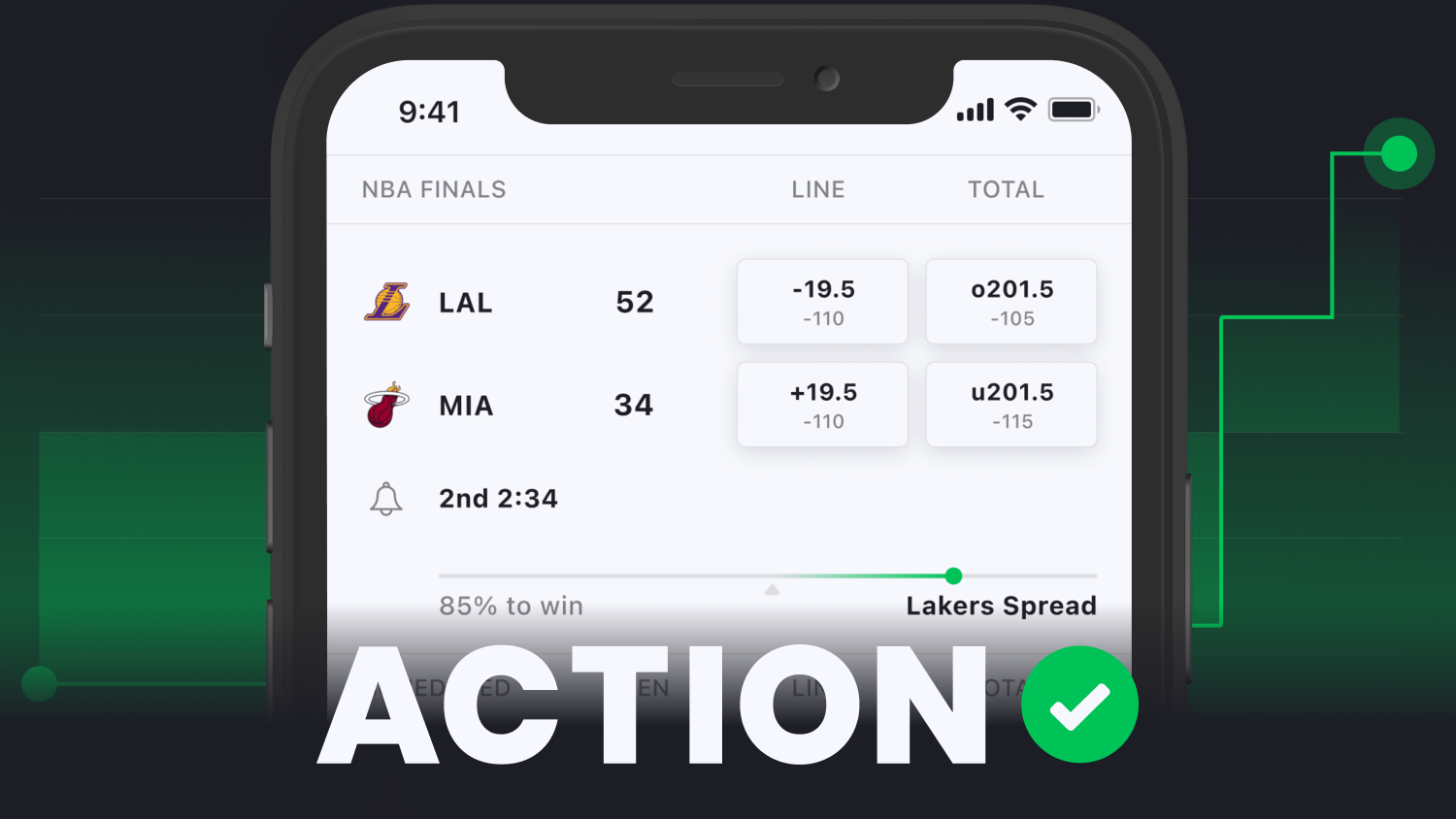2024 NHL Playoffs Fantasy & Pool Rankings, Strategy & Picks: How to Finish First or Dead Last
Candice Ward/Getty Images. Pictured: Jack Eichel of the Vegas Golden Knights
There are two main types of NHL playoff pools:
- Mass entry. Everyone can pick the same players, so you'll end up with most of the pool owning Connor McDavid and Nathan MacKinnon. These pools will be bigger, and you need to differentiate yourself. This is the type of (free) pool our friends at MoneyPuck run every year, and I'll be using it as an example.
- Snake draft, in which only one version of each player is owned. This will typically be among friends, with a max of 8-10 entries, or else you'll quickly run out of players (especially goalies).
I'll cover strategy and tips for both types of pools, starting with mass-entry. If you're doing a snake draft, you can skip to that section by clicking here.
I know my mass-entry strategy may land me in dead last if things go wrong. But when it works, I can actually have a chance to win. Finishing 200th out of 1,000 pays the same as last, so I don't mind using a unique roster construction to give myself a chance if things do break right.
MoneyPuck put together a spreadsheet with every player's projected points for the playoffs. You can make a copy and customize the scoring to your league. For a mass-entry pool, you don't want to blindly use projections because everyone will use the top players. You need to get a little more creative. But this is still useful in finding little edges.
The projections take into account both player talent and how many games they're expected to play in the postseason, which is the name of the game in any playoff fantasy pool.
Here's the format for MoneyPuck's pool. Your pool may be similar:
- Pick three forwards and two defensemen from each conference.
- You don't replace players as they get eliminated.
- Get one point for a goal, expected goal or primary assist, and 0.5 points for a secondary assist, throughout the playoffs.
A. Mass-Entry Pools
So, how do you win a pool like this? You want to treat your roster construction like DFS and get leverage over the rest of the pool by fading some of the best players and creating a lineup that almost no one else has.
And that means you want to get a little weird. It doesn't mean you have to take fourth-liners from the Canucks, or use all Islanders and Capitals. You just have to be unique.
Here's the entry that won MoneyPuck's pool last year. They loaded up on Edmonton, a popular play, but also went heavy on Florida, whom almost no one used because everyone expected the Bruins to make quick work of the Panthers. They played the max games by reaching the Cup final.

1. If You're Not First, You're Last
The goal of these pools is to win. It's not to finish in the top 25%, or "do well." The prizes go to the winner, or the top few finishers. To get there, you have to be different.
- In 2021, I finished 17th of 613 entries in MoneyPuck's pool by not using the most popular players.
- In 2022, I finished almost dead last (1,026th of 1,036) because the most popular players dominated. The favorite (Colorado) won it all, and the most-used player (Connor McDavid) led the pool in points.
- In 2023, I finished 42nd of 1,276 entries by fading every player from Boston, Colorado and Edmonton, the three most-used teams. The Panthers ended up being the optimal play by a mile, but I used Carolina/Toronto in the East instead.
Two finishes in the top 3%, and one finish in the bottom 1%. That's exactly what I'm going for (though I'm due for another dud in 2024, if the pattern holds).
This is the Action Network-approved strategy for any mass-entry pool: Be so different that when it goes wrong, it's a disaster. But when it hits, you may actually win. We've written about the same strategy for Masters pools, NCAA Tournament brackets, NFL survivor pools and more.
If you planned to take all three of McDavid, Matthews and MacKinnon, you'll probably finish in the top 30%, but not in the top 1%, and you can stop reading.
2. Focus on just a few teams & stack your lines
In MoneyPuck's pool, you pick three forwards and two defensemen from each conference. I'll be heavily concentrating my entry around two teams per conference for a few reasons:
- In a pool with 1000+ entries, many of your players need to reach at least the conference finals. Every round your players advance, their expected points scored go up significantly. Even the best players in the world in 12 games will have a hard time outscoring a slightly lesser player who plays 26 games. And if you take one player from every team, several of them will only play one round.
- The NHL's playoff format allows you to take teams from each "pod" so you can nail as many of the conference finalists as possible. You know each team's path already.
- Stacking – using players who play together to maximize your upside – is essential in hockey because almost every time a player scores, a teammate is getting an assist. If the teams you focus on go far, your players will score together. Make sure your players are spending time on the ice together, preferably at both even strength and on the powerplay.
Here is MoneyPuck's expected games for each team.
But what if I pick the wrong teams and they get knocked out in the first round? Shouldn't I split it up and take one player from each team?
No. Splitting it up will help you finish in the top half of the pool, or maybe the top 20%. But it won't help you win. It may slightly increase the entertainment value you derive from this pool. But it won't help you win.
And for you to win, everything has to break right.
If you're in a pool where you select a lot of players or can only take a certain number of players from one team, make sure you're splitting it up so most of your players won't meet until at least the conference finals. That gives you a max of 21 possible games for everyone. And the NHL's playoff format makes it easy to do that, with the four divisional pods.
3. Get Leverage on the Field
So what is leverage? It's the idea that you can get a leg up by taking comparable players who will be far less owned by the rest of the pool. That way, when your players score, you're actually jumping people in the standings. When Connor McDavid scores, you stay in the exact same spot since everyone used him. If you use the same key players as everyone else, the rest of your lineup will have to be absolutely perfect for you to have any chance to win – you have to beat the 500 other Oilers-heavy entries. If you're one of 25 entries who loads up on a long shot (like Florida last year) and that team goes deep, you're competing against only those 25 entries in the end.
Here's a visual of leverage. When 90% of the entries use McDavid and he puts up points, they all move up in the standings together. No one gains any ground on each other. But when a unique team scores points, they move alone and everyone else stays in place.
Here's another example: Last year, Carolina's chances to win the Stanley Cup (about 10%) vs. Boston's (12%) were similar, but the gap between MoneyPuck entries using David Pastrnak (80%) Sebastian Aho (about 15%) was massive.
In a pool like this, you get your leverage from an "unexpected" team advancing. Not using McDavid and Draisaitl but using Ryan Nugent-Hopkins probably won't work, because for RNH to do well, Edmonton needs to advance. And for Edmonton to advance, I imagine McDavid and Draisaitl will be scoring.
You don't want to take the worst teams or players just to do it. You want to take less popular teams and players who actually have a chance to put up points and go far.
My favorite leverage teams this year are the boring ones:
- Golden Knights
- Hurricanes
- Jets
- Predators
I believe some players from the Leafs-Panthers-Bruins-Lightning will go way under-owned because they're all in the same section of the bracket, but I'm not sure exactly how it will shake out. My guess is Tampa.
4. Gamble on Unknowns
In the last few years, there have been some injured stars returning for the playoffs:
- Nikita Kucherov missed the entire 2020-21 season, but he then returned for the postseason and posted 32 points en route to a Stanley Cup.
- Mark Stone didn't play the last three months of the 2022-23 season, and he had 24 points in the playoffs en route to a Stanley Cup. He's in the same situation again this year, though it's pretty clear he'll play, so I don't think it will be a huge surprise.
NHL teams are notoriously tight-lipped about player injuries, but if we've learned anything from those two players, manipulating the Long Term IR is advantageous, and just because a player missed a chunk of the season doesn't mean he won't come back.
I don't believe there are any situations for top players exactly like this entering the 2024 postseason (you weren't going to use Filip Chytil anyway), but it's a good thing to keep in mind. If no one uses an elite player because they're afraid he won't come back, and then he does play, you're getting a massive advantage. If he doesn't play, well, you're toast. But you were probably toast anyway in a 1,200-person pool.
5. Scoring Math
If your pool features goalies, you'll often want to pair your tender with your offense. When your offense is scoring, it means your goalie is winning and advancing so he can win more games.
But understand how the scoring works. If a goalie win is worth two points and a goal/assist are 2/1 points, goalies become pretty valuable. So in that scoring system, the Cup winner would get 32 points from their goalie. McDavid if the Oilers win the Cup could put up 40+ points, for context.
MoneyPuck's pool is a bit unique – goals, expected goals and primary assists are all worth 1 point, and secondary assists are worth 0.5. You get expected goals from shots, so when you score, you are getting a bit of a leg up compared to a primary assist.
People will always gravitate toward goalscorers a bit more than playmakers, so depending on your scoring system, it may make sense to be a bit contrarian and target playmakers.
6. Making Your Roster Unique
We don't have historical data on ownership in these types of pools because they're quite niche, but MoneyPuck usually posts the percentages of entries using the top players, and total usage by team. I'll update this if they post it this year.
The key is to create a unique roster. Not use completely random players. A unique roster.
Here's how the ownership looked last year:
Most common picks so far in our playoff pool. McDavid almost everyone's choice. You can sign-up for our free pool here: https://t.co/J0p8cx9yC5pic.twitter.com/myp8Esaer3
— MoneyPuck.com (@MoneyPuckdotcom) April 16, 2023
More than 90% of entries used Connor McDavid – 90%! The Oilers, Avalanche and Bruins were the most popular teams last year; Boston and Colorado didn't get out of the first round.
You don't need to use all unique, 1%-owned players. You don't need to play Rangers goon Matt Rempe and seventh defenseman Zac Jones. You just need your lineup to be different.
In looking at the data for previous years, here are some things that stand out:
- The most popular roster construction seems to be using the top 2-3 players from the highest-scoring/best team in each division. So last year, you had a lot of McDavid-Draisaitl-MacKinnon-Makar teams in the West, and a lot of Pastranak-McAvoy-Hughes-Hamilton teams in the East. This year, using the Stars, Jets or Knights may give you a big edge.
- Lots of other people split their rosters up across many teams, so you'll get some Tkachuk-Pastranak-Matthews-Panarin-Fox builds in the East, for example. In the West, I still think it will be more concentrated around the Oilers and Avs.
- People gravitate to goalscorers much more than they do playmakers. Matthews is always going to be much more popular than Mitch Marner.
If you want to use the Avs or Oilers, make sure you don't follow the same pattern as everyone else. Use Edmonton, then find a unique team in the East like Tampa or the Islanders.
7. My Team
Hopefully points 1-6 were compelling enough that you now trust my line of thinking, even if you don't trust me. Which is fair.
Even though I liked the contrarian angle more if the Knights played the Oilers in Round 1 – because a Vegas win would essentially eliminate all the entries who used Connor McDavid – I'll still load up on them.
Per MoneyPuck's own projections, Vegas has a nearly identical chance of reaching the finals as Colorado and Dallas.

Here is my entry:
Western Conference
I still believe Vegas won't be popular since they don't have a 100+ point player like the Avs and Oilers, so I'll lead with Jack Eichel and Jonathan Marchessault. Noah Hanafin has been playing on the top power-play unit, which should continue into the playoffs, so I'll use him too.
Preds star Filip Forsberg will be my other winger because I don't think anyone will use him, given the other players available in the West, and Nashville's chances to reach the conference final aren't all that much worse than the other teams in their pod.
I went with Nashville's Roman Josi as my other defenseman because his path to the conference finals won't conflict with Vegas, and I believe the Preds would only need to win one round for him to pay off, given his scoring prowess. Nashville has about a 43% chance to advance past Vancouver, per the betting market.
I also think building around Vancouver is a good option. Their chances to go deep are about the same as Edmonton, and they'll be far-less used.
- Jack Eichel (VGK)
- Jonathan Marchessault (VGK)
- Filip Forsberg (NSH)
- Noah Hanafin (VGK)
- Roman Josi (NSH)
Eastern Conference
I'm a bit chalkier in the East compared to the West for a few reasons. I think the ownership will be much more spread out, and my West lineup is already very unique.
These players all have a legit chance to reach the conference finals, and all play together on the power play. If their teams advance, they'll be scoring. I did consider using Sam Reinhart instead of Tkachuk since I think he'll be less used.
- F: Sebastian Aho (CAR)
- F: Jake Guentzel (CAR)
- F: Matthew Tkachuk (FLA)
- D: Brent Burns (CAR)
- D: Brandon Montour (FLA)
B. Snake Draft Strategy
Some of the same principles apply to snake drafts with 8-10 people, but you can't get every player you want.
MoneyPuck put together a sheet with projected points for the playoffs, based on both ability and projected games. Because MP's projections like the Rangers to go far, Artemi Panarin and Mika Zibanejad are at the top of the list.
You can download that sheet and customize it to your scoring settings, or use the "points per game" column if you disagree with how far these teams will go.
1. Maximize Your Potential Expected Games Played
As your team starts to develop, you want to avoid taking players from the same portions of the bracket. If your first two picks are Matthews and Marner, and then you're choosing between Bruins D Charlie McAvoy and Hurricanes D Brent Burns, take Burns because the earliest they can meet is in the conference finals. The Bruins and Leafs will eliminate each other in Round 1.
You'll also want to make sure to take some players from both the East and West.
2. Opt for Talent & Role over Team
I'm always surprised how quickly role players from the best teams who don't play on the power play fly off the board in these snake drafts. Sure, they may play a lot of games if the team goes far – and I don't mind taking them in the late rounds. But there's just not a ton of scoring upside for some of these players.
That's why I'll try to target players on worse teams who get all the key minutes, including the power play. I believe it's more likely the Predators make a surprise run than Edmonton's third line suddenly explodes for huge production.
Here are MoneyPuck's full playoff projections. Even their favorite, the Rangers, have a 28.2% chance to make the finals. The probability is much more spread out than you think.

3. Two Stacking Options
In snake pools, you can't take all the players you want. You won't be able to get McDavid, Hyman and Draisaitl together because they'll all go in the top-10 picks. Here are your options:
- Pair elite players with role players. So you may get McDavid, and then be able to take Adam Henrique way later, who doesn't play on the power play but did get a look on the first line with McDavid in the last week of the season.
- Stack the best players from worse teams. I don't think you'll have a ton of trouble getting both Islanders Bo Horvat and Matthew Barzal if you want them.
I find that in snake drafts, the best players from the worst teams fall pretty far. In my draft last year, Matthew Tkachuk and Sam Reinhart fell to Round 7-8. Boston third-liners went before them. So that's my preferred option.
Most likely, you'll end up with a few mini-stacks – two players from 3-4 teams. Make sure they're not playing each other in Rounds 1 or 2, and hope they all advance at least one round so they're playing 10+ games.
Some stacks I'd target in the mid-to-late rounds.
- Nashville: They're only +125 against the Canucks in Round 1, meaning they have about a 43% chance to advance if you remove the vig. But they have a few players who can really score and eat up all the usage in key situations. Some combination of Roman Josi, Filip Forsberg and Gus Nyquist makes sense.
- Vegas: Maybe they'll be more popular than I think since they won last year, but their stars don't score at the same clip as the rest of the West teams and there are so many other options in the conference. The lines are also a bit unclear with Mark Stone's return looming. Hertl, Eichel, Stone, Hanafin and Marchessault are good targets in the mid-to-late rounds.
- Islanders: I say this as a Ranger fan – I don't think it's that unreasonable to think the Islanders can get to the conference finals. You can get Barzal, Horvat, etc. super cheap, and if they win a round, it will pay off already. Two rounds and you're really in good shape.
4. Goalie Scoring is Linear; Players Are Not
I don't get too concerned about taking goalies early because in most formats, their scoring is very linear. They mostly get points for wins, so you can only get points in a very linear, logical sequence. Even if your skaters lose a series 4-0 or 4-1, they can still score. A goalie cannot.
And if you revisit the Stanley Cup projections from above, there's not much separating these teams' chances to advance far. (If your scoring is more tilted toward goalies, it changes the calculus).
Let's say your format is 2 points for a goal, 1 for an assist, and 2 for a goalie win.
- Last year, only Vegas, Dallas and Florida's goalies posted 20+ points.
- 18 skaters posted 20+ points.
- Seattle, Carolina and Edmonton were the only other goalies to post 12+ points …
- … and 56 total skaters posted at least 12 points.
Even if your team gets knocked out in Round 2, the skaters still have some upside to score, while the goalies do not.
5. That Said, Don't Overthink It
No one is going to be able to stack an entire team in this format, so you're not at a huge disadvantage if your roster is spread out. Most of your team won't reach the Stanley Cup or even the conference finals, and that's OK. Last year, McDavid and Draisaitl were two of the highest-scoring players in the playoffs despite getting knocked out in Round 2.
If you have an early pick, take the best players, and let the draft develop from there. Don't get too cute trying to nail down six Winnipeg Jets and pass on better players in the process.
How would you rate this article?

